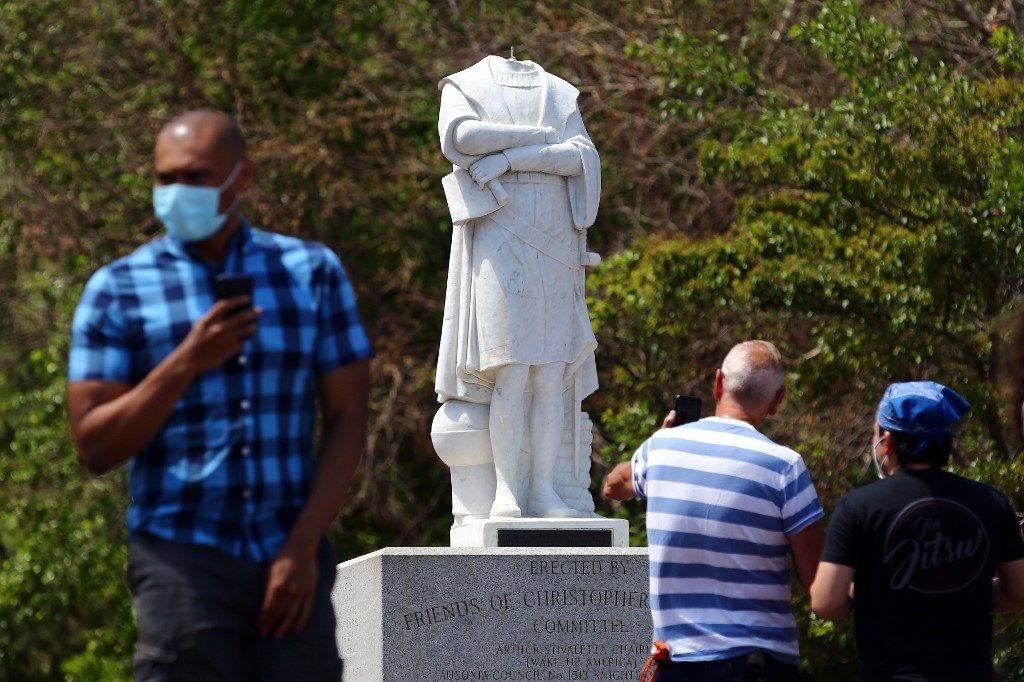SUMMARY
This is AI generated summarization, which may have errors. For context, always refer to the full article.

WASHINGTON, DC, USA – A new national park populated with statues of “American heroes?”
The surprise idea, proposed by President Donald Trump over the July 4 holiday weekend, hardly seems likely to calm the partisan passions deeply dividing the American people.
And it raises questions about what exactly such a park might look like, and whom it will celebrate upon its aspirational opening date of July 4, 2026.
Coming just 4 months before November’s presidential election, the proposal reinforces the image of a president who has given up any pretense of uniting the country, instead choosing to play one voting bloc against another.
Announced without any evident consultation, the proposal comes as demonstrators nationwide have been demanding the removal of – and sometimes forcibly pulling down – certain historic statues, particularly those of generals of the Civil War South seen as glorifying a racist past. (READ: Trump signs order ‘protecting’ monuments as crowds topple statues)
Side-stepping the larger argument and reducing the protest movement to a series of violent acts, the Republican president has positioned himself as a defender of the country’s “integrity” in the face of “the Marxists, the anarchists, the agitators, and the looters.”
To Julian Zelizer, a professor of political history at Princeton University, Trump’s notion of a National Garden of American Heroes is a purely political ploy.
“He is trying to use a specific version of American history to promote his attack on the ‘radical left’ and to appeal to conservatives who might be frustrated with the failed pandemic policies of the administration,” he told AFP.
The president floated the idea during his speech Friday in front of the massive Mount Rushmore sculpture of 4 of his most celebrated predecessors – George Washington, Thomas Jefferson, Abraham Lincoln, and Theodore Roosevelt.
Trump opposes modernist designs, and a White House statement said the park – its venue yet to be decided – would include only “realistic” and not “abstract” likenesses while paying tribute to historic figures “who made substantive contributions to America’s public life.”
Trump’s Rushmore speech was a combative response to anti-racism protesters who have defaced or destroyed statues in several cities, not just of Civil War generals but also of celebrated Americans who, in some cases, owned slaves.
Trump said the “vast outdoor park” he envisions “will feature the statues of the greatest Americans to ever live.”
But just who will they be? And who will decide?
A tentative list cited in a presidential decree features a grab-bag of figures, including George Washington; the civil rights leader Martin Luther King Jr; frontiersman Davy Crockett; popular evangelist Billy Graham; former president Ronald Reagan; and the late Supreme Court justice Antonin Scalia, a pillar of the conservative right.
Not included were any modern figures from the American left.
‘Odd’ choices
“Some of the choices for those to be honored are direct outreach to the right – Justice Scalia, for example – as are the absences, such as Franklin Roosevelt,” said Zelizer.
To James Grossman, who heads the American Historical Association, “the choices vary from odd to probably inappropriate to provocative,” he told The Washington Post.
In addition to celebrating figures from public and private American life, ranging from political leaders to inventors and sports stars, the White House said the park could include non-Americans who made significant contributions to “the discovery, the development, or the independence” of the country.
It mentioned Christopher Columbus and the Marquis de La Fayette, the young Frenchman who fought on the American side in the Revolutionary War.
Also mentioned was the Spanish friar Junipero Serra, who founded several Catholic missions in 18th-century California. Pope Francis canonized him in 2015, though some Native Americans say he was part of a violent and destructive colonizing process.
Several statues of Columbus – who forged a reputation for brutality in his voyages to the New World – have been vandalized or pulled down in recent weeks across the US, most recently in Baltimore, Maryland. And the city of San Francisco removed a Columbus statue from before its City Hall.
Trump mentioned the explorer explicitly in remarks July 4 from the White House.
“We will defend, protect, and preserve the American way of life, which began in 1492 when Columbus discovered America,” Trump said.
American politicians have so far had little to say about the president’s proposal.
A notable exception was Eugene Scalia, the labor secretary in the Trump administration.
Saying he was deeply touched by the idea of a statue of his father being included in the new park, he praised the concept.
“We need heroes,” he said on Fox News. “We need to admire our forebears and recognize what is great and good in our past.
“And that is what the president is emphasizing right now.” – Rappler.com
Add a comment
How does this make you feel?
There are no comments yet. Add your comment to start the conversation.